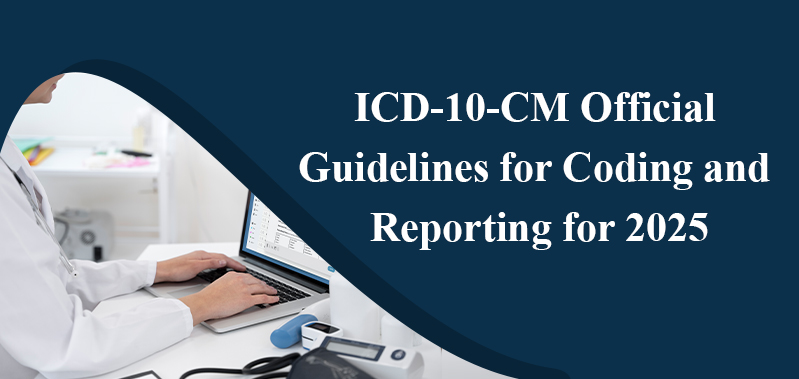
ICD-10-CM Official Guidelines for Coding and Reporting for 2025
Understanding the intricacies of ICD-10-CM coding can seem daunting, but it's a crucial aspect of healthcare documentation. The Centers for Medicare and Medicaid Services (CMS) and the National Center for Health Statistics (NCHS) have established guidelines to make this process smoother. These guidelines, which should be used alongside the official 2025 ICD-10-CM Code Updates, are essential for accurate coding and reporting in all healthcare settings.
What is ICD-10-CM?
The ICD-10-CM (International Classification of Diseases, 10th Revision, Clinical Modification) is a system used by healthcare providers to classify and code all diagnoses, symptoms, and procedures recorded in conjunction with hospital care in the United States. Based on the World Health Organization’s (WHO) ICD-10, this system ensures uniformity in the classification of diseases and health conditions, enabling better data collection and health statistics.
Adhering to Guidelines Under HIPAA
Compliance with these guidelines is mandatory under the Health Insurance Portability and Accountability Act (HIPAA). The ICD-10-CM codes, which are adopted under HIPAA for all healthcare settings, require meticulous attention to ensure accurate documentation and reporting. A collaborative effort between healthcare providers and coders is essential for the successful assignment with 2025 ICD - 10 - CM Code Updates.
Structure of the Guidelines
The guidelines are meticulously organized into sections to aid healthcare providers and coders for 2025 ICD - 10 - CM Code Updates:
- Section I: This section covers the structure and conventions of the classification system, along with general guidelines applicable to the entire classification. It also includes chapter-specific guidelines corresponding to the various chapters in the classification.
- Section II: Focused on the selection of the principal diagnosis for non-outpatient settings, this section provides detailed instructions on how to determine the primary condition for which a patient is being treated.
- Section III: This section outlines the guidelines for reporting additional diagnoses in non-outpatient settings, ensuring comprehensive documentation of all relevant health conditions.
- Section IV: Dedicated to outpatient coding and reporting, this section emphasizes the nuances of coding in an outpatient context.
The Key changes in 2025 ICD-10-CM
- New Codes for Emerging Conditions: One of the most significant updates for 2025 is the addition of new codes for emerging diseases. This includes conditions that have recently become more prevalent or have been newly identified. For example, the rise in awareness of post-viral syndromes has led to the inclusion of specific codes that better capture these conditions, ensuring that patient records are as detailed and accurate as possible.
- Expanded Mental Health Codes: Mental health has been a focal point in recent years, and the 2025 update reflects this with expanded codes for mental health and substance use disorders. These updates allow for more precise documentation of conditions such as anxiety, depression, and various addiction disorders. The increased granularity helps in creating a more comprehensive patient history, which is essential for effective treatment planning.
- Refinements in Chronic Disease Codes: Chronic diseases like diabetes and hypertension have seen refinements in their coding structure. The updated codes provide more detail on the complications and comorbidities associated with these conditions. For instance, new subcategories for diabetes now include specific codes for complications affecting different organ systems, which can lead to more tailored treatment approaches.
- Enhanced Injury Codes: The injury codes have also been enhanced to capture more specific details about the nature and cause of injuries. This includes new codes for injuries related to sports activities, workplace accidents, and even specific types of fractures. These changes are aimed at improving the accuracy of injury reporting, which is crucial for both treatment and legal documentation.
The Importance of Complete Documentation
Accurate coding hinges on consistent and complete documentation within the medical record. It’s imperative that healthcare providers thoroughly review the entire patient record to identify the specific reasons for the encounter and the conditions treated. The term “encounter” encompasses all settings, including hospital admissions, and "provider" refers to any qualified healthcare practitioner accountable for establishing the patient’s diagnosis.
Looking Ahead to 2025
As we approach the 2025 ICD-10-CM updates, it’s important to stay informed about the changes and understand how they will impact your practice. New codes for emerging conditions, expanded mental health codes, refinements in chronic disease classifications, and enhanced injury codes are just a few of the updates to expect. Regular training, the use of updated coding software, and collaboration with peers are essential strategies for staying ahead. By adhering to these guidelines and leveraging the resources provided by the Cooperating Parties, healthcare providers and coders can ensure accurate and effective documentation, ultimately enhancing patient care and facilitating better health outcomes.





This blog provides an excellent overview of the upcoming changes in the 2025 ICD-10-CM guidelines.